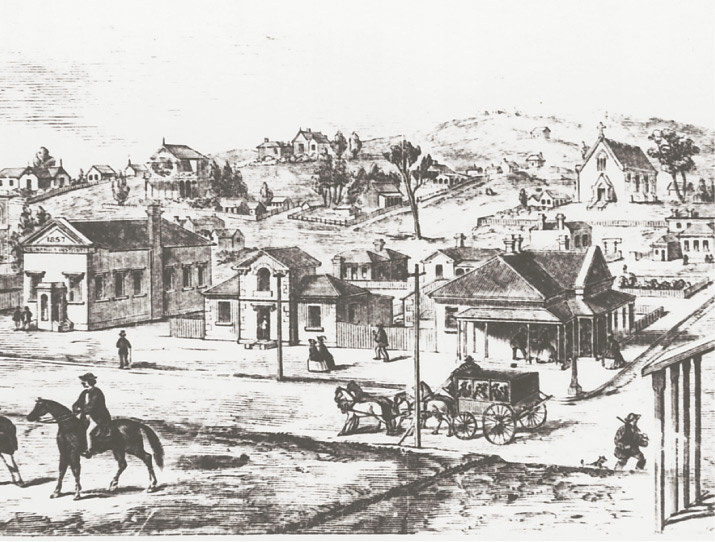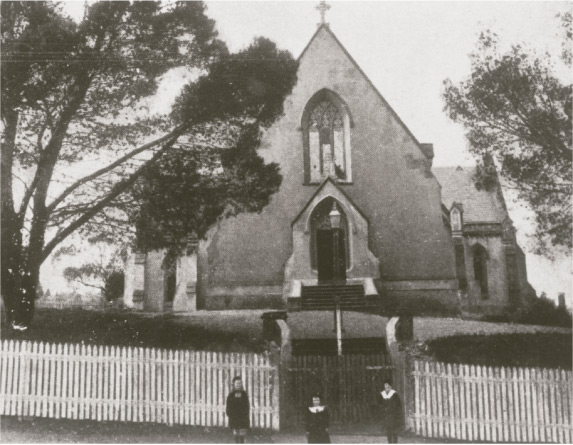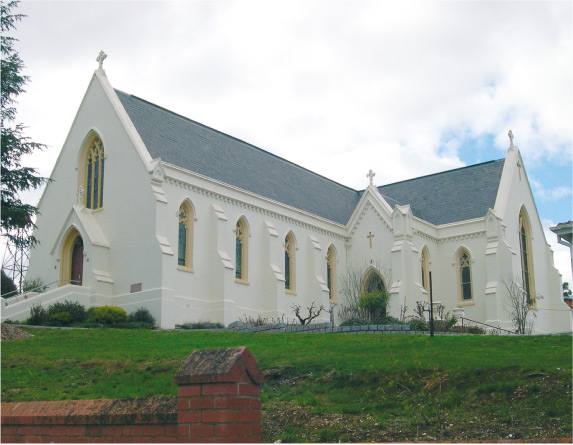Humble Beginnings
In 1852, German priest Doctor Henry Backhaus arrived to take charge of all Catholics between Kyneton and the Murray. Dr Backhaus made frequent trips to Castlemaine from Bendigo and celebrated fortnightly Mass at the Gold Commissioner’s camp (near Gaulton St) from April 25th 1852. Not until late 1853 was the first temporary chapel built, by Father Stack of Kyneton, in the grounds of the present church. It was a flimsy affair, of wooden slabs and a canvas top which flapped “as in a gale” during the service. Father Thomas Barrett, in 1854, became Castlemaine’s first resident priest and the diggers showed their appreciation by adding a slab and canvas room to the chapel. In 1854 Castlemaine became a separate parish (extending as far as Avoca).

A stone church
The wooden church remained in service until 1857 when Fr Smyth announced plans for “a magnificent cathedral in the Elizabethan style”. Eminent sculptor Frederick Poepel was chosen as architect, and the first stone laid on Sunday September 13th 1857. Bishop Goold dedicated the work to the Blessed Virgin under the title of the Holy Name of Mary and the first portion of the new church was opened by the Bishop in January 1858. A small brick presbytery was built soon after. In 1864 a fine marble altar was installed and in 1866 the transept and chancel were blessed. The adornment of the church continued with the main three windows over the altar installed in 1890 and an oak pulpit a few years later. The two side altars were added in 1899.

Lovingly restored
Little was done to St Mary’s for the next hundred years other than basic repairs and the changes wrought by Vatican Two. In the late 1990s however, large scale restoration work got under way, under Father Michael Kalka, and proceeded in earnest with the arrival of Father Des Magennis in 1999. The major restoration project saw the slate roof renewed, rendering replaced inside and out, major work to the substructure and floors, new carpet, rewiring, heating, lighting and sound system, paving and more. A marble altar from Cabrini hospital was installed and the church painted inside and out. Work was completed in October 2000 and the church blessed by Bishop O’Connell on March 11th 2001.

St Brigid’s Maldon
In 1857 Father Smyth began collecting for a permanent chapel in Maldon. A two acre block was purchased and the money quickly raised, prompting the Mount Alexander Mail to remark on “the example and energy and liberality thus displayed by the Roman Catholics among us.” The brick building, of 40 x 16 feet, was dedicated under the rare title of St Saviour’s and doubled as a school for a short time.
By the late 1880s, the old church was showing serious signs of decay and
Father Collins was given task of collecting funds for a new one. The foundation stone of the present church, St Brigid’s, was laid in May 1891 and 6 months later the church was opened. St Brigid’s was described in the Mt Alexander Mail as “a fine brick building in the gothic style”, and the church was blessed by his grace the Archbishop of Melbourne, Archbishop Carr on Sunday September 27th 1891.
St Laurence O’Toole’s Sandon
A small wooden school (22’x14’) was erected in Sandon by Father Smyth in 1859 (and at Golden Point) which was also used for Mass and came to be regarded as a chapel. Twenty-three years later, a brick church was built by Father Allen at a cost of 1000 pounds. The church was blessed by Archbishop Goold on May 6th 1883 and dedicated to St Laurence.
The 1940s saw some refurbishment and in 2002 a major restoration project was undertaken. St Lawrence’s was restored from roof to footings, by a dedicated band of volunteers and trades people. Work was completed mid 2003 and in November 2003 St Laurence’s was re-dedicated with the celebration of Mass and a picnic tea. Mass is celebrated here on the fourth Sunday of each month.
St Anne’s Newstead
Dean Hegarty blessed the newest of our parish churches, St Anne’s in 1911 and it has served the Catholic parishioners for almost 100 years. At one time a small cottage existed behind the church to house the priest when he stayed overnight, although the time of its demise is unknown. The mid 1990s saw refurbishment when the church was repainted and new carpet laid. Mass is celebrated at St Anne’s on the second Sunday of each month.

